General
In the ponds and
swamps, one may find floating, rootless plants with
hundreds of tiny, balloon-like sacs attached to their green
branching stems. They are bladderworts, yet another kind of
carnivorous plants. These sacs in the water are
sophisticated miniature traps designed to provide animal
meals for these rootless floaters. 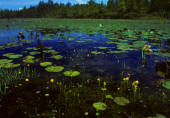 There are about 214 species of
bladderworts worldwide, occurring in
practically every part of
the globe except in arid regions and
Antarctica. Some are terrestrial species found in
moist-to-wet, often acid soils, and in sphagnum moss
?? , while
others are aquatic, preferring to be floating freely in
quiet waters in bogs and lakes. Many terrestrial species
in the tropics are epiphytic. Some species exhibit
an intermediate lifestyle, capable of adapting to either
terrestrial or semi-aquatic habitats depending on the amount
of rainfall of the season. Of all the bladderworts in the
world, terrestrial species, by far, are
the majority. (about 80%) Thirty-some
species of bladderworts are found in the
continental U.S. There are about 214 species of
bladderworts worldwide, occurring in
practically every part of
the globe except in arid regions and
Antarctica. Some are terrestrial species found in
moist-to-wet, often acid soils, and in sphagnum moss
?? , while
others are aquatic, preferring to be floating freely in
quiet waters in bogs and lakes. Many terrestrial species
in the tropics are epiphytic. Some species exhibit
an intermediate lifestyle, capable of adapting to either
terrestrial or semi-aquatic habitats depending on the amount
of rainfall of the season. Of all the bladderworts in the
world, terrestrial species, by far, are
the majority. (about 80%) Thirty-some
species of bladderworts are found in the
continental U.S.The bladderworts are perennial or
annual, consisting of long branching stems bearing numerous,
tiny, balloon-like sacs -- or bladders -- for which the
common name was given. The genus name Utricularia
is derived from the Latin word utriculus also
referring to a "small bag".
Morphologically,
the arrangement of the vegetative organs of Utricularia is
quite peculiar in view of the general norm of the
flowering plants. Following Taylor (1989), the general
vegetative morphology of Utricularia is described as
follows:
Utricularia
does not have roots but in many (terrestrial) species
structures that resemble and function as roots exist. These
organs are termed rhizoids (Taylor 1989). A vertical
stem is present only in a few species. In the
majority of
species, horizontal shoots called stolons form the
framework of the vegetative part of the plant (Taylor). Some
aquatic species produce air shoots, arising from the
stolons. The true function of this structure is not well
understood.
Utricularia has the green,
flat, sometimes feather-like organs that perform
photosynthesis. There are some disputes as to what to call
them (whether these
organs should properly be called leaves). "It seems reasonable to me",
Taylor (1989) writes, "that plants which have, in
defiance of the general rule, no radicle or roots and no
true cotyledons, may be allowed to have leaves which also
disobey the rules... "
In some
aquatic species, a dense cluster of leaves is formed at the
growth point of the stolon at the end of the growing season.
This is (called) a turion, a term for hiberncula (winter buds)
often used for aquatic species. Turions are resistant to low
temperature and desiccation.
The traps of all
known carnivorous plants are considered (to be) a modified leaf,
morphologically speaking, with Utricularia being the
only exception.
Positioning of the
traps in Utricularia is highly diverse in
relation to the other vegetative organs of the plant, and this
offers significant taxonomic characters (Taylor).
In some species the
traps arise only from the stem or the peduncle base, while
in some others the trap appears at the tip of the leaf. In
terrestrial species, the traps may arise on leaves, stolons,
and also on rhizoids. In many aquatic species, the traps
are formed laterally on the leaves or leaf segments (Taylor).
Inflorescence
Inflorescence is
always racemorse (Taylor 1989), meaning the flower scape.....
Corolla is always
two-lipped. (bilabiate) without an obvious tube (unlike
Pinguicula). The upper lip is small er than the lower. The
lower lip of the corolla always terminates in a spur, as in
Pinguicula. The expanded part (limb) of the lower lip has
(at its base) a palate. The front end of the lower lip ???
is either entire or lobed, depending on the species.
The calyx of
Utricularia is always two-lobed, except in subgenus
Polypompholyx which has a four-lobed calyx. The calyx lobes,
in many cases, provide useful taxonomic characters in
species where the corolla morphology is often variable
(Taylor). In cases where corolla shapes have a high degree
of variation, the calyx lobes are, of all the floral organs,
probably the most useful in providing taxonomic character,
according to Taylor (1989).
Many species
produce a reduced-size flower that self-pollinates without
opening. This form of flower is called cleistogamous. In
some species, cleistogamous flowers coexist with normal,
open, chasmogamous flowers. In a terrestrial U.S. species,
Utricularia subulata, cleistogamy is quite common. In an
aquatic species Utricularia geminiscapa, a short-stemmed
cleistogamous flower is produced underwater along with an
open, chasmogamous flower that protrudes above the water
surface.
The bladder
interior ?? contains two kinds of glands, bifids (two-armed
glands) and quadrifids (four-armed glands).... the relative
disposition of the arms of the quadrifids provides
diagnostic taxonomic character...
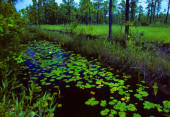 The bladderworts present a rather
unique morphology. First of all, the plants are entirely
rootless -- completely giving up the normal plant way of
obtaining nutrients from the root system. Also, the
distinction between stem and leaf is often vague, especially
in the aquatic species. The trapping mechanism, the bladder,
is a modified leaf or a leaf division morphologically, in
general conformity with all trapping structures found in
carnivorous plants of other genera. The inner surface of the
trap (bladder) corresponds to the upper surface of the leaf
division that it represents. The bladderworts present a rather
unique morphology. First of all, the plants are entirely
rootless -- completely giving up the normal plant way of
obtaining nutrients from the root system. Also, the
distinction between stem and leaf is often vague, especially
in the aquatic species. The trapping mechanism, the bladder,
is a modified leaf or a leaf division morphologically, in
general conformity with all trapping structures found in
carnivorous plants of other genera. The inner surface of the
trap (bladder) corresponds to the upper surface of the leaf
division that it represents.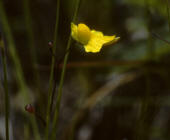 ??????/ ??????/
The terrestrial species extends its
white stems in the damp soils from which arise green leaves
and slender flower stems above the ground. Numerous white
bladders are attached to the stem. In aquatic species,
branching stems and bladders are also greenish, indicating
photosynthetic in function, and the leaves are often
feathery and thread-like. During the growing season, aquatic
species float near the surface of the still waters with only
the flower scapes protruding above the water surface.
Inflorescence
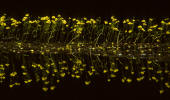 The flowers are generally quite
colorful and showy for both terrestrial and aquatic species,
especially when seen in masses. During the flowering, which
occurs from spring to late summer in the U.S. species, one
often finds the ponds covered with bright yellow or purple
corollas. This seems to be the only time these small ,
obscure plants choose to announce their existence to the
rest of the world. Yellow is the most prevalent flower color
for this genus though white to purple or bluish flowers are
also common often with yellow or reddish markings. The flowers are generally quite
colorful and showy for both terrestrial and aquatic species,
especially when seen in masses. During the flowering, which
occurs from spring to late summer in the U.S. species, one
often finds the ponds covered with bright yellow or purple
corollas. This seems to be the only time these small ,
obscure plants choose to announce their existence to the
rest of the world. Yellow is the most prevalent flower color
for this genus though white to purple or bluish flowers are
also common often with yellow or reddish markings.
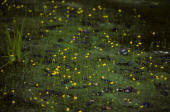 Although most of the U.S. species are
relatively small and less noticeable than other
carnivorous plant species, sometimes even in flower, some
South American terrestrial species are massive in size, with
leaves reaching one foot (1 m??) or more in length.
Their
flower scapes may attain the height of 1m. Some of these
flowers compete with those of orchids in their beauty
and elegance. Although most of the U.S. species are
relatively small and less noticeable than other
carnivorous plant species, sometimes even in flower, some
South American terrestrial species are massive in size, with
leaves reaching one foot (1 m??) or more in length.
Their
flower scapes may attain the height of 1m. Some of these
flowers compete with those of orchids in their beauty
and elegance.
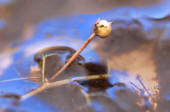
Suction Trap
The traps range in size from 5 mm at the largest end to a
microscopic 0.3 mm. These sacs are highly sophisticated
mechanical traps capable of
catching tiny water animals with amazing efficacy.
The traps come complete with
a self-resetting mechanism The
typical prey for these miniature traps includes insect
larvae (esp. those of mosquitoes), aquatic worms, water
ticks, and other tiny swimmers sharing the same habitat.
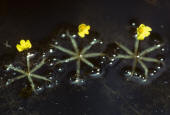 The basic structure and function of
the traps are common for all species of bladderworts,
though there are some clear differences
between
terrestrial and aquatic species. Each trap has some antenna-like
hairs on one side of the trap opposite the attaching stem.
These hairs are non-irritable (non-sensitive) and are
considered ornamental in nature, contributing to attract
tiny animal prey to the trap entrance located just below the
base of the hairs. The hairs may also serve to protect the
entrance from flowing debris in the water. The lower half of
the entrance is a semi-circular valve -- or a door --
hinged at the upper semi-circular arc, with the free edge of
the door tightly sealed in contact with
the firm collar of the
lower opening of the entrance, called threshold. The door
opens only inwardly. When the trap is set, with the door
sealed watertight, the pressure inside the trap is kept
lower than the outside. This happens because the water is
constantly being pumped out of the trap interior by glands
scattered all over the trap wall. Because of this pressure
differential, when the trap is viewed from above, the walls
are warped inwards and appear concave. The basic structure and function of
the traps are common for all species of bladderworts,
though there are some clear differences
between
terrestrial and aquatic species. Each trap has some antenna-like
hairs on one side of the trap opposite the attaching stem.
These hairs are non-irritable (non-sensitive) and are
considered ornamental in nature, contributing to attract
tiny animal prey to the trap entrance located just below the
base of the hairs. The hairs may also serve to protect the
entrance from flowing debris in the water. The lower half of
the entrance is a semi-circular valve -- or a door --
hinged at the upper semi-circular arc, with the free edge of
the door tightly sealed in contact with
the firm collar of the
lower opening of the entrance, called threshold. The door
opens only inwardly. When the trap is set, with the door
sealed watertight, the pressure inside the trap is kept
lower than the outside. This happens because the water is
constantly being pumped out of the trap interior by glands
scattered all over the trap wall. Because of this pressure
differential, when the trap is viewed from above, the walls
are warped inwards and appear concave.
On the lower part of the outer surface
of the door grow tiny, stiff hairs.
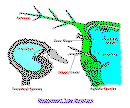 These hairs function as
a trigger lever. When a small water animal, probably seeking
a shelter in the bladderwort jungle or perhaps lured by
nectar secretion, touches one of these levers, a delicate
mechanical latch of the door is broken. Giving in
to the outside water pressure, the door
swings open inwardly, causing
the water animal to be sucked into the trap along with a bladderful of rushing water. The elastic trap bulges with an
in-rush of water, with the side walls of the trap popping up
in a normal convex shape. The door swings shut in a fraction of a
second, closing the entrance once again. All this happens in
an astonishing 1/30 to 1/40 of a
second. Once trapped inside, there is no hope left for the
prey.
Over a period of thirty minutes to an
hour, the trap mechanism is automatically set
again in
preparation for the next catch. This resetting is the result
of continuous pumping of water out of the trap interior. These hairs function as
a trigger lever. When a small water animal, probably seeking
a shelter in the bladderwort jungle or perhaps lured by
nectar secretion, touches one of these levers, a delicate
mechanical latch of the door is broken. Giving in
to the outside water pressure, the door
swings open inwardly, causing
the water animal to be sucked into the trap along with a bladderful of rushing water. The elastic trap bulges with an
in-rush of water, with the side walls of the trap popping up
in a normal convex shape. The door swings shut in a fraction of a
second, closing the entrance once again. All this happens in
an astonishing 1/30 to 1/40 of a
second. Once trapped inside, there is no hope left for the
prey.
Over a period of thirty minutes to an
hour, the trap mechanism is automatically set
again in
preparation for the next catch. This resetting is the result
of continuous pumping of water out of the trap interior.
Water Pumping
Mechanism
On
the inner surface of the trap are found numerous glands with
four projections known as quadrifids.
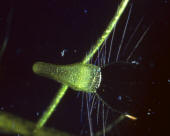 These quadrifids are
believed to be responsible for absorbing water from
the trap
interior. Tiny spherical glands seen on the outer surface of
the trap are known to engage in active transport of ions
from the trap interior. The osmotic pressure (gradient)
built up by the ion movement generates the outward flow of
water from the trap interior. These quadrifids are
believed to be responsible for absorbing water from
the trap
interior. Tiny spherical glands seen on the outer surface of
the trap are known to engage in active transport of ions
from the trap interior. The osmotic pressure (gradient)
built up by the ion movement generates the outward flow of
water from the trap interior.
Digestion
During a period of several days,
trapped animals are digested and absorbed by quadrifids,
and the nutrients are carried away to the rest of the plant. The digestive
enzymes, believed to be secreted from the quadrifids,
have been
detected inside the trap -- at least in younger traps.
After the first prey is captured, the bacterial actions are
seen to dominate in the digestive process
and the trap often appears dark purple
in color. In an animal-rich environment, it is
not unusual for each trap
to capture several water
animals, filling the tiny trap completely.
Mechanical Delicacy
As we have seen, the water tightness
is essential for the proper function of
the suction-trap mechanism of
the bladderworts. Let us take a look at the mechanical
subtlety of this structure. Referring to this elaborate
trap structure, F. E. Lloyd, who contributed
immensely to our present knowledge of the
trap mechanism,
comments, " ... But most to be wondered at are the traps
which present an astounding degree of mechanical delicacy
depending on a fineness of structure scarcely equaled
elsewhere in the plant kingdom."
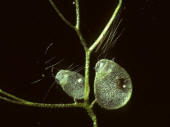 The surface of the threshold --
against which the door edge rests -- is covered with a
pavement epithelium of sessile glands secreting mucilage.
There is a slight depression on the middle of the pavement
where the cells are most densely packed. The middle of the
free edge of the door -- which is strengthened with by dense
cells to make a firm edge -- rests in the pavement
depression. A slight change in
the door posture when the trap
becomes fully set is reflected in the trigger lever position
which is now more erect. Note that only the center of the
door edge impinges tightly on the pavement depression, with
the other portions of the free edge of the door merely lying
flat against the pavement, leaving chinks through which
the water can enter. This water leakage is prevented by the cuticular membrane attached to the outer edge of the
pavement, running completely across the threshold. This thin
but firm membranous tissue is called velum, which serves as
the second valve of the trap entrance, covering the outer
edge of the free margin of the door. That is, when the door
swings back right after springing the trap, it pushes
against the velum. Mucilage secreted from the stalked glands
on the threshold near the door rest also helps
seal the door further to prevent water leakage. This keeps the door
water-tight against the increasing outside pressure as the
water is continuously being pumped out from within the trap.
As long as this delicate mechanical balance of the door
latch is undisturbed, the door remains sealed in spite of
the mounting pressure outside. The surface of the threshold --
against which the door edge rests -- is covered with a
pavement epithelium of sessile glands secreting mucilage.
There is a slight depression on the middle of the pavement
where the cells are most densely packed. The middle of the
free edge of the door -- which is strengthened with by dense
cells to make a firm edge -- rests in the pavement
depression. A slight change in
the door posture when the trap
becomes fully set is reflected in the trigger lever position
which is now more erect. Note that only the center of the
door edge impinges tightly on the pavement depression, with
the other portions of the free edge of the door merely lying
flat against the pavement, leaving chinks through which
the water can enter. This water leakage is prevented by the cuticular membrane attached to the outer edge of the
pavement, running completely across the threshold. This thin
but firm membranous tissue is called velum, which serves as
the second valve of the trap entrance, covering the outer
edge of the free margin of the door. That is, when the door
swings back right after springing the trap, it pushes
against the velum. Mucilage secreted from the stalked glands
on the threshold near the door rest also helps
seal the door further to prevent water leakage. This keeps the door
water-tight against the increasing outside pressure as the
water is continuously being pumped out from within the trap.
As long as this delicate mechanical balance of the door
latch is undisturbed, the door remains sealed in spite of
the mounting pressure outside.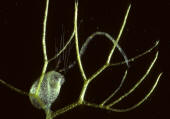
Suppose a tiny water animal touches the tip
of a trigger lever.
By the lever action,
the door edge
is pulled out from the pavement depression, thus unlatching
the door lock. Giving in to the outside water pressure, the
door flaps open inwardly. As expected from its mechanical
structure, the downward push of the lever is most effective in
triggering the trap.
Besides pumping of water by
the wall
glands -- which is physiological in nature -- setting,
tripping, and resetting of the trap are purely mechanical
phenomena, unrelated to growth movement. Therefore, one
bladder can repeat the trapping action without any
biological growth limitation. Some observer counted 14 times
of resetting of the bladderwort trap and this is not the
limit. |










